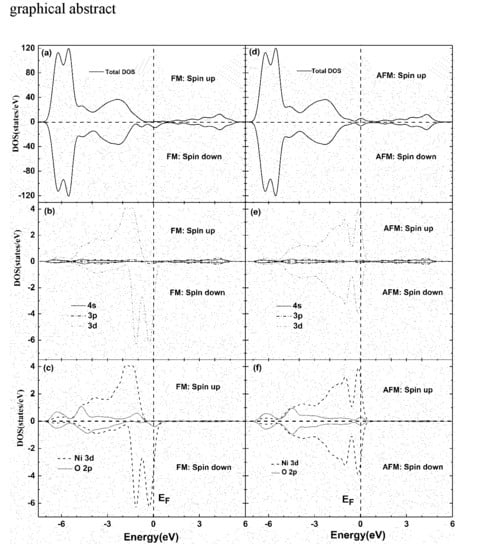Electronic and Magnetic Properties of Ni-Doped Zinc-Blende ZnO: A First-Principles Study
Abstract
:1. Introduction
2. Theoretical Models and Calculated Methods
3. Results and Discussion
4. Conclusions
Author Contributions
Acknowledgments
Conflicts of Interest
References
- Dietl, T.; Ohno, H.; Matsukura, F.; Cibert, J.; Ferrand, D. Zener Model Description of Ferromagnetism in Zinc-Blende Magnetic Semiconductors. Science 2000, 287, 1019–1022. [Google Scholar] [CrossRef] [PubMed]
- Ball, P. Meet the spin doctors. Nature 2000, 404, 918–920. [Google Scholar] [CrossRef] [PubMed]
- Wolf, S.; Awshalom, D.D.; Buhiman, R.A.; Daughton, J.M.; von Molnár, S.; Roukes, M.L.; Chtchelkanova, A.Y.; Treger, D.M. Spintronics: A Spin-Based Electronics Vision for the Future. Science 2001, 294, 1488–1495. [Google Scholar] [CrossRef] [PubMed]
- Dietl, T. A ten-year perspective on dilute magnetic semiconductors and oxides. Nat. Mater. 2010, 9, 965974. [Google Scholar] [CrossRef] [PubMed]
- Wang, Z.Y.; Liu, Y.Y.; Huang, B.B.; Dai, Y.; Lou, Z.Z.; Wang, G.; Zhang, X.Y.; Qin, X.Y. Progress on extending the light absorption spectra of photocatalysts. Phys. Chem. Chem. Phys. 2014, 16, 2758–2774. [Google Scholar] [CrossRef] [PubMed]
- Rekha, K.; BNirmala, M.; Nair, M.; Anukaliani, A. Structural, optical, photocatalytic and antibacterial activity of zinc oxide and manganese doped zinc oxide nanoparticles. Phys. B Condens. Matter 2010, 405, 3180–3185. [Google Scholar] [CrossRef]
- Ketsko, V.A.; Beresnev, E.N.; Kop’eva, M.A.; Elesina, L.V.; Baranchikov, A.I.; Stognii, A.I.; Trukhanov, A.V.; Kuznetsov, N.T. Specifics of the pyrohydrolytic and solid-phase syntheses of solid solutions in the (MgGa2O4)x(MgFe2O4)1−x system. Russ. J. Inorg. Chem. 2010, 55, 427–429. [Google Scholar] [CrossRef]
- Nipan, G.D.; Ketsko, V.A.; Stognij, A.I.; Trukhanov, A.V.; Kol’tsova, T.N.; Kop’eva, M.A.; Elesina, L.V.; Kuznetsov, N.T. Properties of Mg(Fe1−xGax)2O4+δ solid solutions in stable and metastable states. Inorg. Mater. 2010, 46, 429–433. [Google Scholar] [CrossRef]
- Kaur, J.; Singhal, S. Facile synthesis of ZnO and transition metal doped ZnO nanoparticles for the photocatalytic degradation of Methyl Orange. Ceram. Int. 2014, 40, 7417–7424. [Google Scholar] [CrossRef]
- Tian, C.G.; Zhang, Q.; Wu, A.; Jiang, M.; Liang, Z.; Jiang, B.; Fu, H. Cost-effective large-scale synthesis of ZnO photocatalyst with excellent performance for dye photodegradation. Chem. Commun. 2012, 48, 2858–2860. [Google Scholar] [CrossRef] [PubMed]
- Sato, K.; Katayamayoshida, H. Material designs for transparent ferromagnetic with ZnO based magnetic semiconductors. Jpn. J. Appl. Phys. 2014, 39, L555–L558. [Google Scholar] [CrossRef]
- Ueda, K.; Tabata, H.; Kawai, T. Magnetic and electric properties of transition-metal-doped ZnO films. Appl. Phys. Lett. 2001, 79, 988–990. [Google Scholar]
- Igamberdiev, K.T.; Yuldashev, S.U.; Kwon, Y.H.; Kang, T.W.; Chizhik, S.A.; Trukhanov, A.V.; Rakhimova, S.M. Magnetic phase transitions in Zn1−xMnxO. J. Korean Phys. Soc. 2014, 64, 1457–1460. [Google Scholar] [CrossRef]
- Liu, C.; Yun, F.; Morko, H. Ferromagnetism of ZnO and GaN: A review. Mater. Sci. Mater. Electron. 2005, 16, 555–597. [Google Scholar]
- Zhao, R.B.; Hou, D.L.; Guo, J.M.; Zhen, C.M.; Tang, G.D. Room temperature ferromagnetism in Ni doped ZnO powders. J. Supercond. Nov. Magn. 2010, 23, 1261–1265. [Google Scholar] [CrossRef]
- Liu, X.; Lin, F.; Sun, L.; Cheng, W. Doping concentration dependence of room-temperature ferromagnetism for Ni-doped ZnO thin films prepared by pulsed-laser deposition. Appl. Phys. Lett. 2006, 88, 062508. [Google Scholar] [CrossRef]
- Cui, J.B.; Gibson, U.J. Electrodeposition and room temperature ferromagnetic anisotropy of Co and Ni-doped ZnO nanowire arrays. Appl. Phys. Lett. 2005, 87, 133108. [Google Scholar]
- He, H., Jr.; Lao, C.S.; Chen, L.J.; Davidovic, D.; Wang, Z.L. Large-scale Ni-doped ZnO nanowire arrays and electrical and optical properties. J. Am. Chem. Soc. 2005, 127, 16376–16377. [Google Scholar] [CrossRef] [PubMed]
- Wakano, T.; Fujimura, N.; Morinaga, Y.; Abe, N.; Ahida, A.; Ito, T. Magnetic and magneto-transport properties of ZnO: Ni films. Phys. E 2001, 10, 260–264. [Google Scholar] [CrossRef]
- Al-Harbi, T. Hydrothermal synthesis and optical properties of Ni doped ZnO hexagonal nanodiscs. J. Alloys Compd. 2011, 509, 387–390. [Google Scholar] [CrossRef]
- Cheng, C.; Xu, G.; Zhang, H.; Luo, Y. Hydrothermal synthesis Ni-doped ZnO nanorods with room-temperature ferromagnetism. Mater. Lett. 2008, 62, 1617–1620. [Google Scholar] [CrossRef]
- Yin, Z.; Chen, N.; Yang, F.; Song, S.; Chai, C.; Zhong, J.; Qian, H.; Ibrahim, K. Structural, magnetic properties and photoemission study of Ni-doped ZnO. Solid State Commun. 2005, 135, 430–433. [Google Scholar] [CrossRef]
- Jaffe, J.E.; Hess, A.C. Hartree-Fock study of phase changes in ZnO at high pressure. Phys. Rev. B 1993, 48, 7903. [Google Scholar] [CrossRef]
- Kresse, G.; Furthmiiller, J. Efficiency of ab-initio total energy calculations for metals and semiconductors using a plane-wave basis set. Comput. Mater. Sci. 1996, 6, 15–50. [Google Scholar] [CrossRef]
- Perdew, J.P.; Burke, K.; Ernzerhof, M. Generalized gradient approximation made simple. Phys. Rev. Lett. 1996, 77, 3865. [Google Scholar] [CrossRef] [PubMed]
- Pfrommer, B.G.; Cote, M.; Louie, S.; Cohen, M.L. Relaxation of crystals with the Quasi-Newton method. J. Comput. Phys. 1997, 131, 233–240. [Google Scholar] [CrossRef]
- Jadhav, J.; Biswas, S. Shape-controlled magnetic nanoplatelets of Ni-doped ZnO synthesized via a chemical precursor. J. Alloys Compd. 2016, 664, 71–82. [Google Scholar] [CrossRef]
- Vijayaprasath, G.; Murugan, R.; Mahalingam, T.; Ravi, G. Comparative study of structural and magnetic properties of transition metal (Co, Ni) doped ZnO nanoparticles. J. Mater. Sci. Mater. Electron. 2015, 26, 7205–7210. [Google Scholar] [CrossRef]
- Grabchikov, S.S.; Trukhanov, A.V.; Trukhanov, S.V.; Kazakevich, I.S.; Solobay, A.A.; Erofeenko, V.T.; Vasilenkov, N.A.; Volkova, O.S.; Shakin, A. Effectiveness of the magnetostatic shielding by the cylindrical shells. J. Magn. Magn. Mater. 2016, 398, 49–53. [Google Scholar] [CrossRef]
- Trukhanov, A.V.; Grabchikov, S.S.; Solobai, A.A.; Tishkevich, D.I.; Trukhanov, S.V.; Trukhanova, E.L. AC and DC-shielding properties for the Ni80Fe20/Cu film structures. J. Magn. Magn. Mater. 2017, 443, 142–148. [Google Scholar] [CrossRef]
- Mulliken, R.S. Electronic population analysis on LCAO-MO molecular wave functions. J. Chem. Phys. 1955, 23, 1833. [Google Scholar] [CrossRef]
- Xu, H.; Sun, W.; Qiu, X.; Wang, L.X.; Yu, M.; Zhang, Q.T. Structural, magnetic and microwave absorption properties of Ni-doped ZnO nanofibers. J. Mater. Sci. Mater. Electron. 2017, 28, 2803–2811. [Google Scholar] [CrossRef]
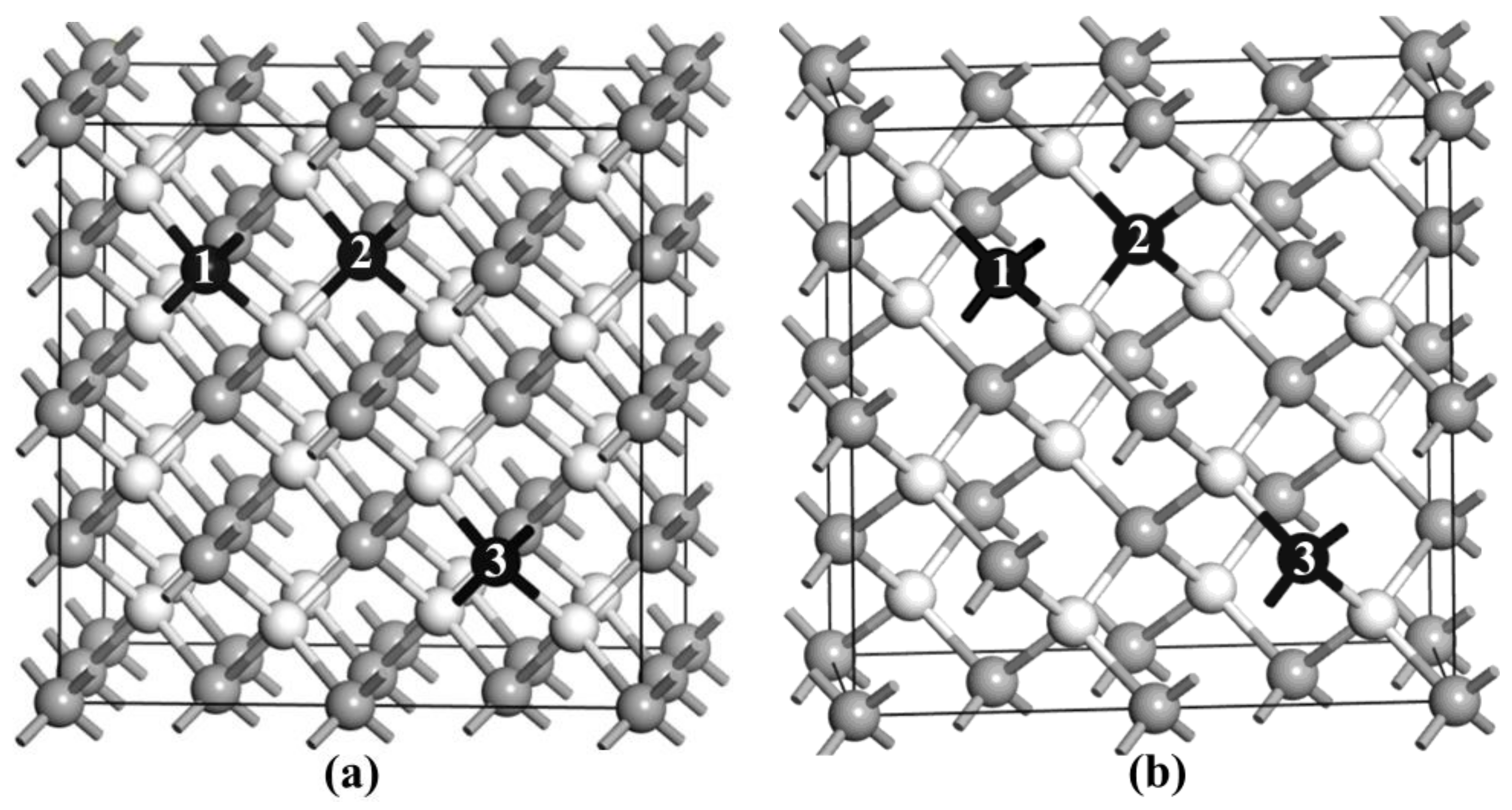
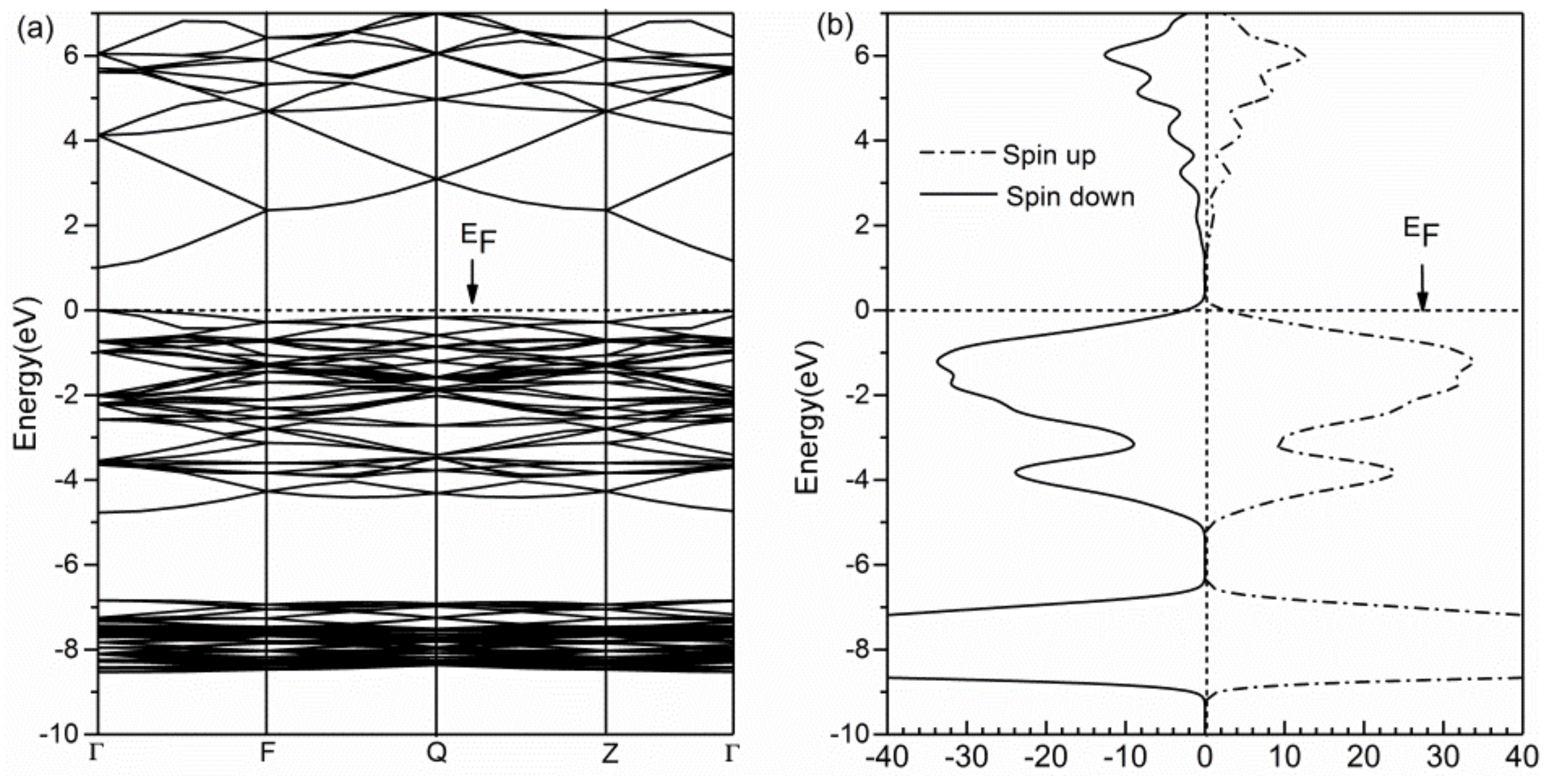

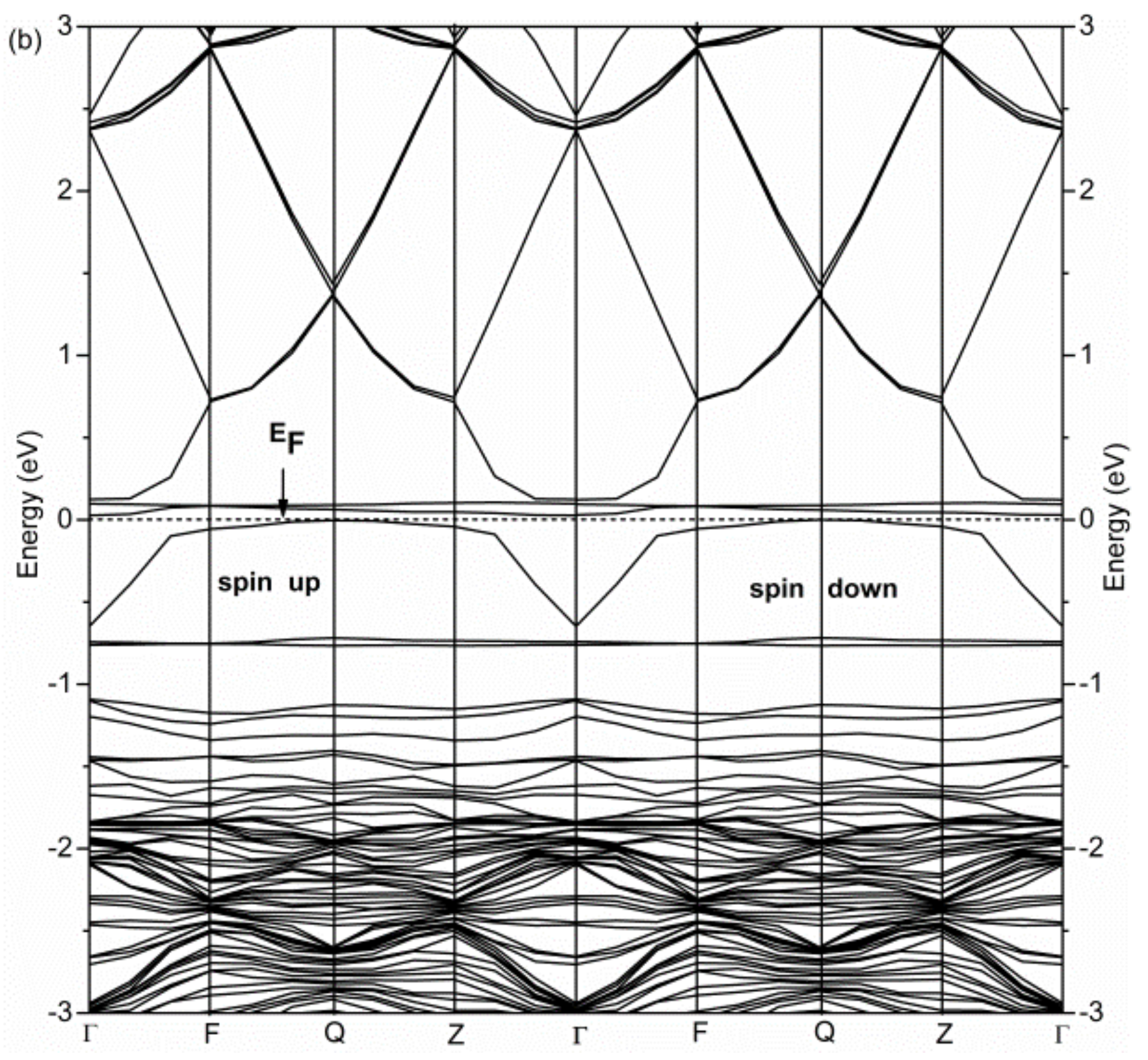
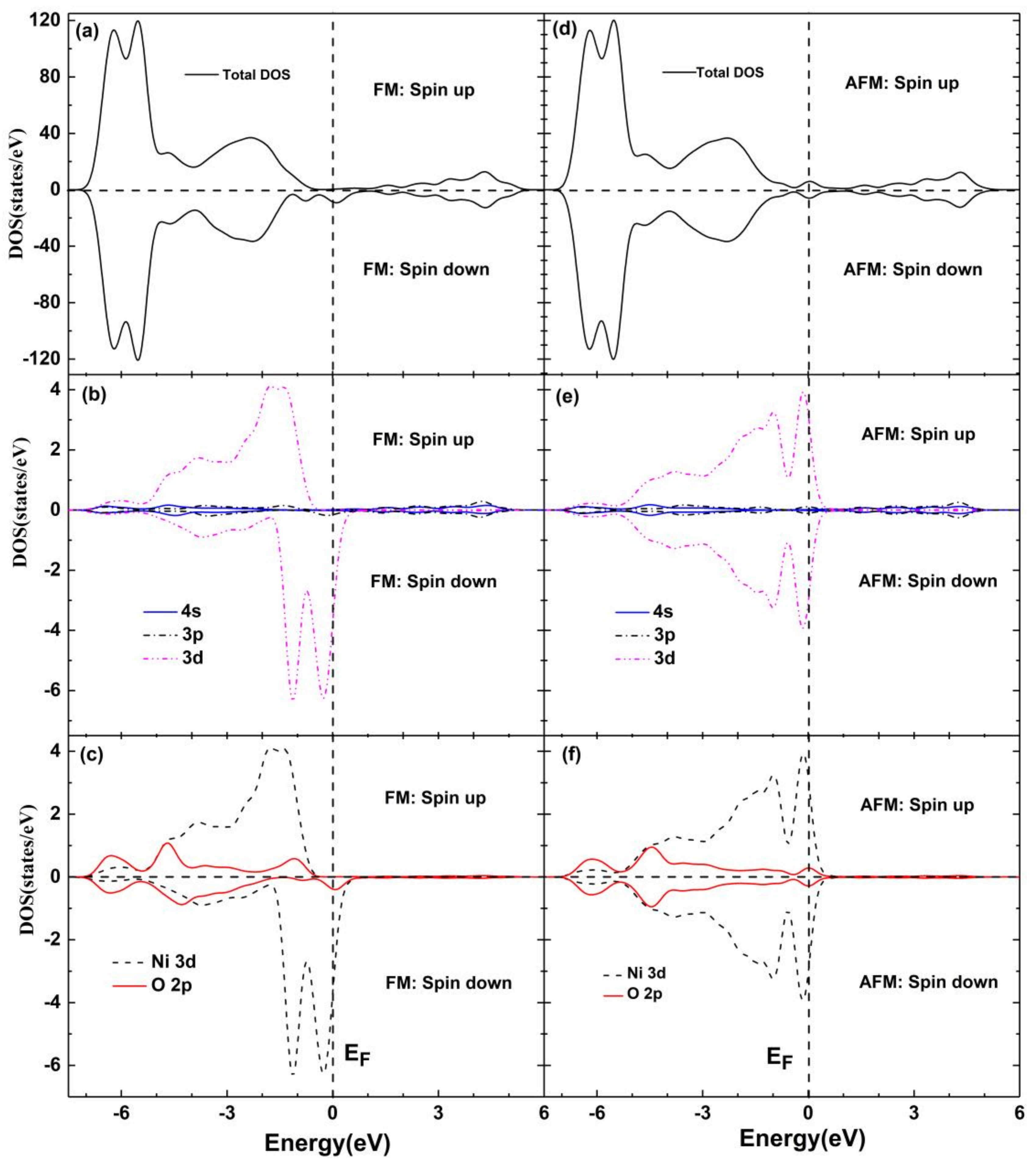
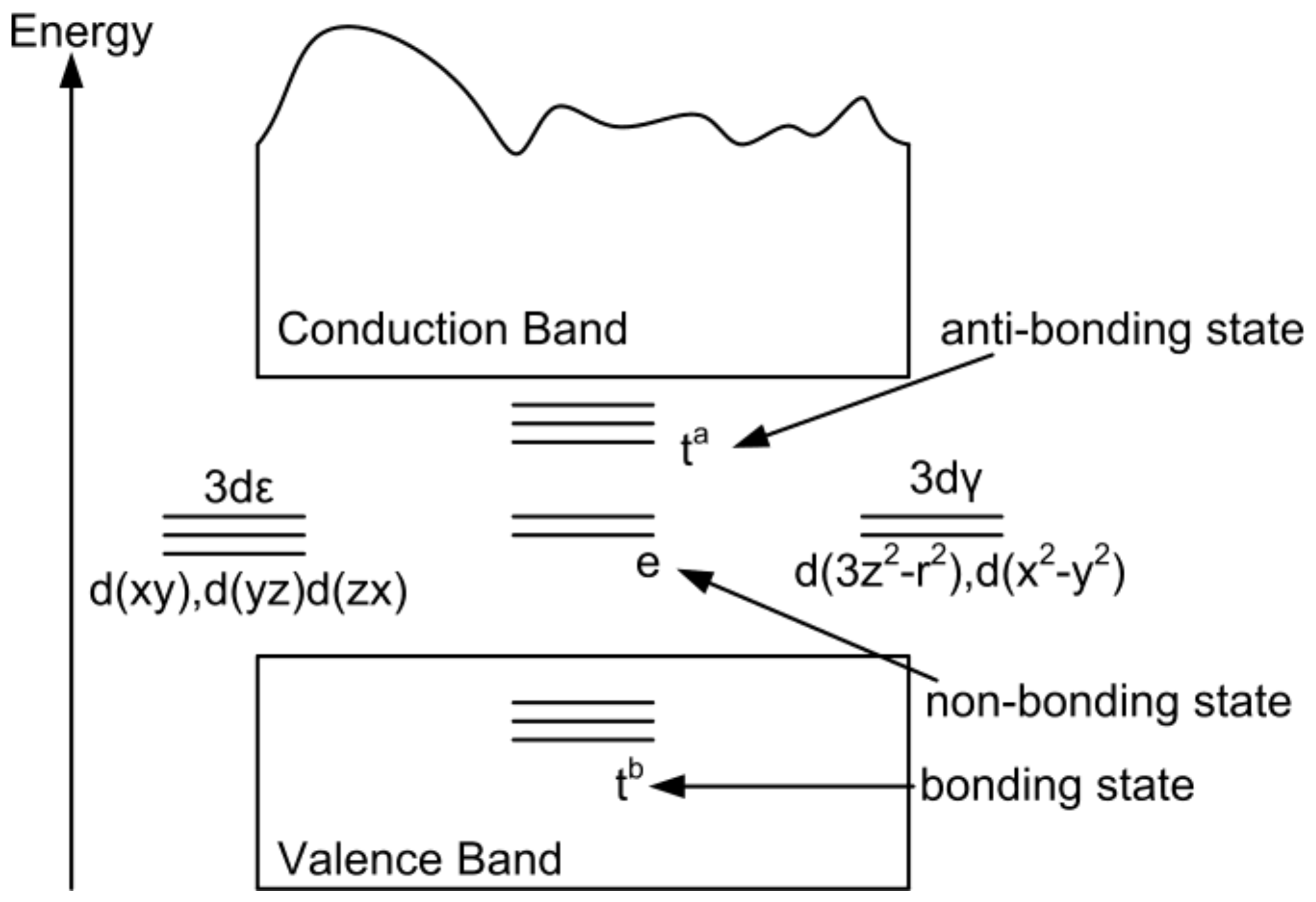
| Lattice Constant | Ni Position | a (Å) | b (Å) | c (Å) |
|---|---|---|---|---|
| Zn32O32 | - | 9.26 | 9.26 | 9.26 |
| Configuration I (Zn30Ni2O32) | 1,2 | 9.5304 | 9.5493 | 9.5304 |
| Configuration II (Zn30Ni2O32) | 1,3 | 9.5303 | 9.5303 | 9.5494 |
| Configuration III (Zn14Ni2O16) | 1,2 | 4.6981 | 9.4918 | 9.4863 |
| Configuration IV (Zn14Ni2O16) | 1,3 | 4.6893 | 9.4919 | 9.4939 |
| Composition | Coupling | Energy (eV) | Ni–O (Å) | Zn–O (Å) | Ni1 (μB) | Ni2 (μB) | O (μB) | Population | ∆E (eV) |
|---|---|---|---|---|---|---|---|---|---|
| Zn32O32 | - | −68072.1 | - | 2.003 | - | - | - | 0.35 | - |
| Configuration I | AFM | −68055.4 | 2.045 | 2.060 | 0.77 | −0.77 | 0.05 | 0.40 | 0.5 |
| Configuration I | FM | −68055.9 | 2.053 | 2.061 | 0.79 | 0.79 | 0.11 | 0.41 | |
| Configuration II | AFM | −68055.3 | 2.064 | 2.065 | 0.81 | −0.81 | 0.07 | 0.38 | 0.2 |
| Configuration II | FM | −68055.5 | 2.064 | 2.065 | 0.79 | 0.80 | 0.07 | 0.37 |
© 2018 by the authors. Licensee MDPI, Basel, Switzerland. This article is an open access article distributed under the terms and conditions of the Creative Commons Attribution (CC BY) license (http://creativecommons.org/licenses/by/4.0/).
Share and Cite
Xue, S.; Zhang, F.; Zhang, S.; Wang, X.; Shao, T. Electronic and Magnetic Properties of Ni-Doped Zinc-Blende ZnO: A First-Principles Study. Nanomaterials 2018, 8, 281. https://doi.org/10.3390/nano8050281
Xue S, Zhang F, Zhang S, Wang X, Shao T. Electronic and Magnetic Properties of Ni-Doped Zinc-Blende ZnO: A First-Principles Study. Nanomaterials. 2018; 8(5):281. https://doi.org/10.3390/nano8050281
Chicago/Turabian StyleXue, Suqin, Fuchun Zhang, Shuili Zhang, Xiaoyang Wang, and Tingting Shao. 2018. "Electronic and Magnetic Properties of Ni-Doped Zinc-Blende ZnO: A First-Principles Study" Nanomaterials 8, no. 5: 281. https://doi.org/10.3390/nano8050281



